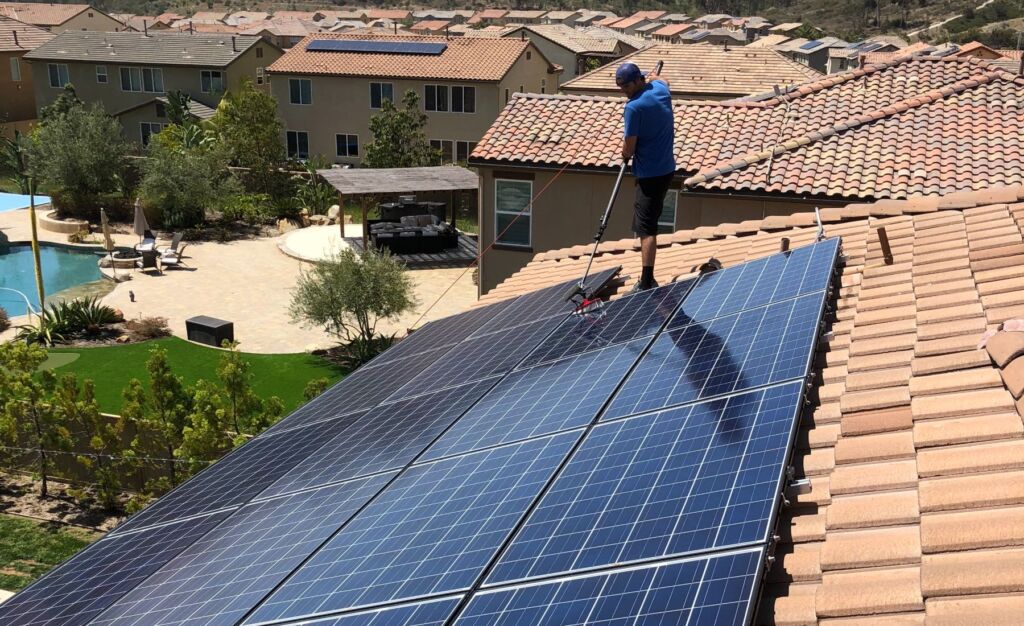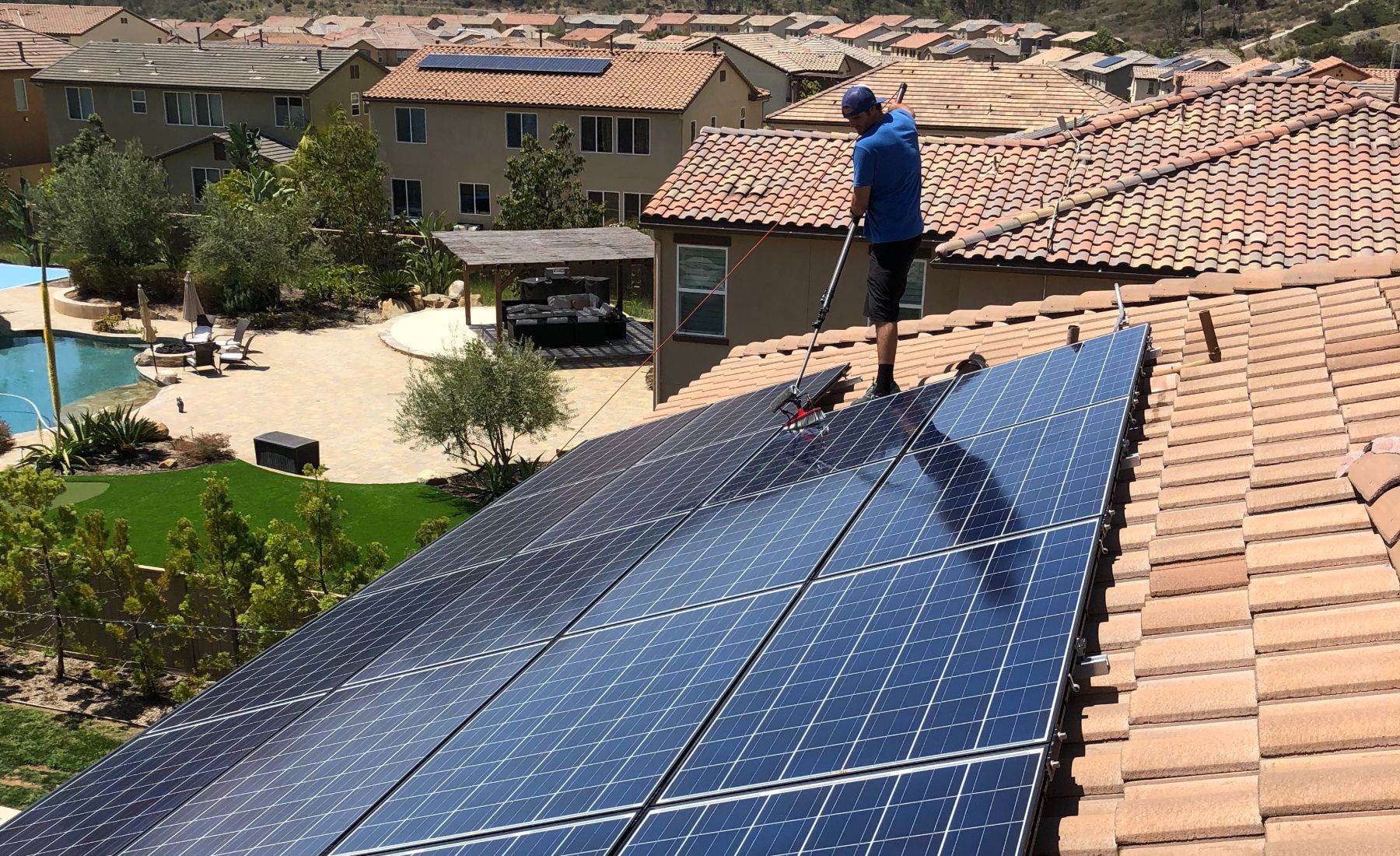Residential solar panel cleaning has the potential to require a lot of working at height. The more working at height you do, the higher the chance of a fall from height becomes.
In a research paper based on 32 years of data from the NIOSH Fatality Assessment and Control Evaluation program researchers found that 54% of workers involved in a fatal accident had no access to a personal fall arrest system. Another 23% did have access to a personal fall arrest system but did not use it.
Additionally, if we have a look at OSHA’s most cited violations, the ‘Duty to have fall protection’ for the construction (29 CFR 1926.501) is the most cited standard for 10 years in a row. From which we can deduct that many worksites either do not have fall protection or are not using their fall protection equipment properly.
These statistics clearly show that there is much to win in the field of using fall protection, especially for the solar panel cleaning industry.

Unsafe solar panel cleaning practices like this are commonplace
Here we discuss legislation and guidance for working at height and how this affects the residential arm of the solar panel cleaning industry.
Working At Height Health & Safety Legislation
The American health and safety organisation OSHA has numerous pieces of guidance for working at height. These are often quoted as referring to the ‘employer/employee’ scenario, not for sole traders. In other countries such as the U.K. the Health & Safety Executive (HSE) can issue fines and even prison terms to sole traders who break health & safety codes.
Irrespective of the legality and risk of fines, the risks of working at height are increased for lone workers. There may be no one aware of a fall and no one nearby to help, should a fall occur. There may be no one around to help you if you are stranded or hanging after a fall. Worse still, if the fall incapacitates you via broken bones or if you are unconscious, the help you need is greater still if lone working.
So whilst Amercian OSHA regulations may only be enforceable by Law to employers and employees, the principles governing lone working and working at height still prevail, even to sole traders. The effects of gravity affect everyone in the same way and the effect of a fall should still be taken into account whilst working.
What Do OSHA Say About Working At Height?
OSHA say plenty about working at height. Other health and safety bodies such as EU/OSHA in Europe and HSE in the U.K. provide extremely similar guidance as that outlined below.
According to OSHA 1910.28(b)(1)(i) anyone ‘on a walking-working surface with an unprotected side or edge that is 4 feet (1.2m) or more above a lower level is protected from falling by one or more of the following:
- 28(b)(1)(i)(A) – Guardrail systems;
- 28(b)(1)(i)(B) – Safety net systems; or
- 28(b)(1)(i)(C) – Personal fall protection systems, such as personal fall arrest, travel restraint, or positioning systems.
- 28(b)(1)(ii) – When the employer can demonstrate that it is not feasible or creates a greater hazard to use guardrail, safety net, or personal fall protection systems on residential roofs, the employer must develop and implement a fall protection plan that meets the requirements of 29 CFR 1926.502(k) and training that meets the requirements of 29 CFR 1926.503(a) and (c).
OSHA guidance is also equally as clear regarding work done at roof level when dealing with the distance from the edges of a roof:
- 28(b)(13)(i) – When work is performed less than 6 feet (1.6 m) from the roof edge, the employer must ensure each employee is protected from falling by a guardrail system, safety net system, travel restraint system, or personal fall arrest system.
- 28(b)(13)(ii) – When work is performed at least 6 feet (1.6 m) but less than 15 feet (4.6 m) from the roof edge, the employer must ensure each employee is protected from falling by using a guardrail system, safety net system, travel restraint system, or personal fall arrest system. The employer may use a designated area when performing work that is both infrequent and temporary.
- 28(b)(13)(iii) – When work is performed 15 feet (4.6 m) or more from the roof edge, the employer must:
- 28(b)(13)(iii)(A) – Protect each employee from falling by a guardrail system, safety net system, travel restraint system, or personal fall arrest system or a designated area. The employer is not required to provide any fall protection, provided the work is both infrequent and temporary; and
- 28(b)(13)(iii)(B) – Implement and enforce a work rule prohibiting employees from going within 15 feet (4.6 m) of the roof edge without using fall protection in accordance with paragraphs (b)(13)(i) and (ii) of this section.
To summarise, OSHA guidance states that were a worker is working more than 4 feet above a lower level and less than 15 feet from a roof edge, fall protection must be implemented. This is the case on the vast majority of residential homes in America and other countries. Therefore, the ‘Hierarchy of Control’ should still be considered.
What Is The ‘Hierarchy of Control’?
The hierarchy of control assesses the risk of working at height and encourages one to consider how to reduce the working at height risk on residential properties.

The Hierarchy of Control should be considered on residential jobs
Step One: Eliminate working at height if possible.
In the case of solar panel cleaning, 45’-60’ poles are commercially available to reach solar panels from ground level and provide an effective clean. This is the case for dusty, as well as more urban areas where traffic film may be the reason the panels are dirty. Where the pitch of the house roof allows for cleaning from ground level, this should be the cleaning technique of choice.
OSHA guidance cannot cover every eventuality in every segment of every industry. However, interestingly, the Canadian version of OSHA, the Canadian Centre for Occupational Health & Safety (CCOSH) specifically mentions the following regarding accessing objects at height: “Using a device that allows the material to be handled from a safe location, (e.g. an extended pole to reach higher areas instead of using ladders).” Like window cleaning, solar panel cleaning definitely fits into that category. Many solar panels can and should be cleaned from ground level wherever possible.

The Hierarchy of Fall Protection should be considered for commercial and residential jobs
What if the solar panels cannot be reached from ground level? What engineering controls can be used to reduce works at heights? What administrative controls can be used to reduce risk? What PPE should be worn when cleaning solar panels? All of these questions are answered in Residential Solar Panel Cleaning Working At Height Guidance – Part 2.


Leave A Comment